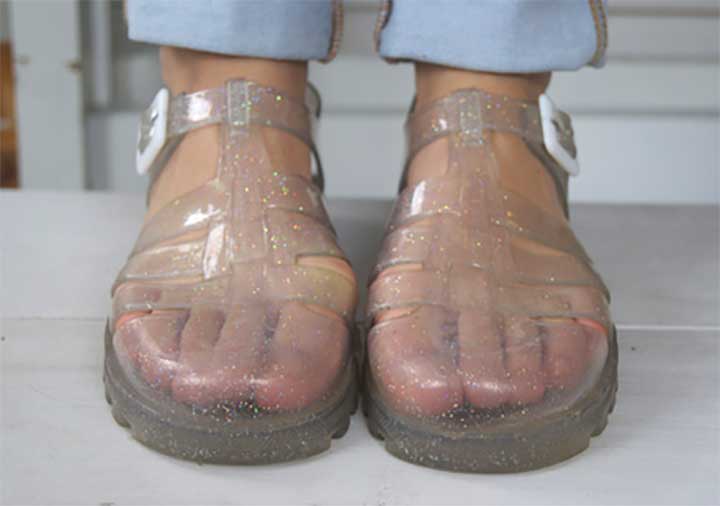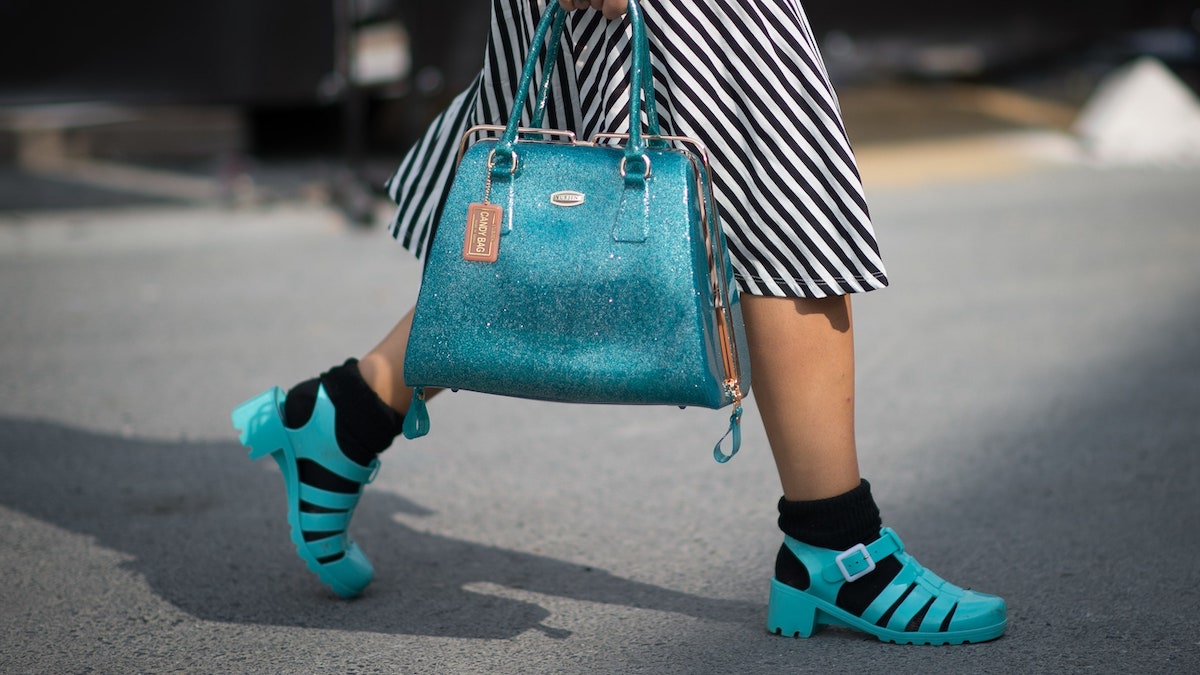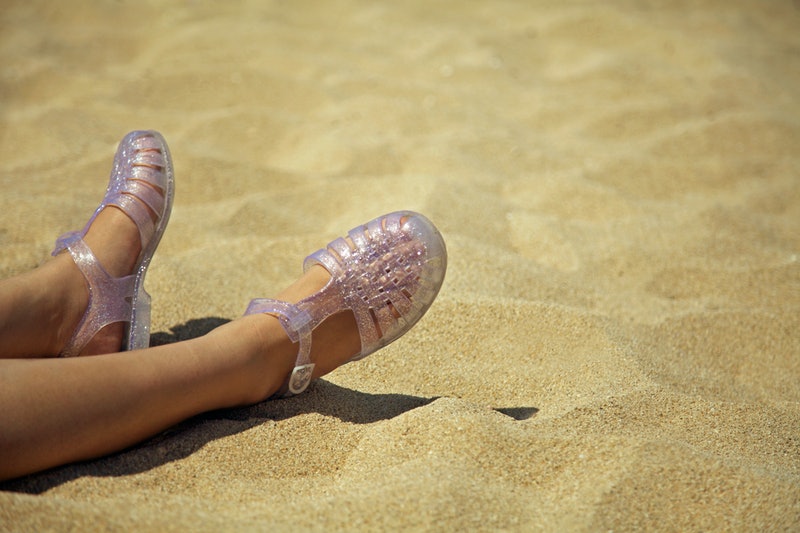The ‘80s and ‘90s were a chaotic yet beautiful mess of iconic fashion trends that initially, won’t seem to work in today’s fashion scene. But you’d be surprised with the big comebacks of these fashion statements — particularly the jelly shoes.
They’re vibrant, they’re campy and they’re made of PVC — jelly shoes (otherwise known as jellies) were the standard footwear during the ‘80s and ‘90s, especially for women and kids. These jelly pop shoes are made of plastic that has a semi-transparent material, which gives the shoes their jelly-like sheen (thus, earning them the name ‘jelly shoes’).
Jellies made a comeback when celebrities and other big names in fashion wore their jelly shoes. Actress Blake Lively was spotted walking around New York City with her $7,050 Louis Vuitton handbag, printed Mango maxi dress and a striped Aritzia coat, which she capped off with jelly sandals that you can buy on Amazon. Luxury brand Gucci stepped in the jelly trend by releasing their now best-selling rubber slide sandals, which cost $350 for a pair!
With jelly shoes returning to the fashion scene, it poses the question, “Should you add jellies to your wardrobe now?”
What are Jelly Shoes? The History of the Jellies
As mentioned above, jelly shoes are footwear made of PVC plastic. Typically, these shoes and sandals have several straps to hold the shoe to your feet and a heel strap that you can either buckle or not.
Like other footwear, jelly pop shoes have been produced in a variety of styles, which include models with extremely flat soles or block heels.
With the history of jelly shoes, pinpointing out the exact origin can be tough since they came from different regions. One of the long-standing theories about the jellies is that their production started in France after the Second World War.
The leather shortage drove shoe producers to look for another material that was readily available. On the other hand, others claim that the jelly shoes are a product of fashion designers turning to plastic during the ‘50s and ‘60s.
Regardless of their true origin, jelly shoes were a hit in the ‘80s. The earlier jelly slides and shoes were produced by Grendene, a Brazilian company. The Grendha Shoe Corporation distributed and marketed the shoes in the US. At that time, the shoe cost from $10 to $20. Despite the affordable price tag, the shoemakers restyled their jelly shoes every six months or so to stay ahead of the game.
The fashion scene loved these shoes, particularly the women and children. Jelly shoes are versatile — they can be colored or clear, solid or woven, bejeweled or glittered and opaque or translucent.
Jelly shoe enthusiasts rave about the shoes because they’re affordable (it reached a point where they were sold for less than $1), easy to clean and comfortable to wear (although this can be debatable).
Since their rise to popularity during the early 1980s, jelly shoes have been on a roller coaster ride. Despite being heavily associated with the ‘80s, they still appeal to today’s customers.
The Anatomy of Jelly Shoes

The creation of jelly shoes is a straightforward process. In technical terms, jelly shoes are called ‘injection-molded soft plastic footwear’ since they are formed through the process of injection molding.
Shoemakers adjust the shoes’ color, texture, rigidity and other physical characteristics using PVC resin and other additives. A mix-and-match of additives is a part of the shoe creation process to ensure the best quality of jelly slides, shoes and sandals.
As mentioned above, jelly shoes are available in different shapes and sizes. Since injection-molded plastic is soft, shoemakers can make any shoe style easily.
If you want to revisit your love for jelly shoes, you need not pick the same styles you wore as a kid. PVC footwear includes pumps, boots, sandals, flats and even ballet slippers. Some come with bows and stylized straps whereas others are fancier, with their rhinestones and other sparkly adornments.
For the winter season, you can also find jelly shoes that are lined with warmer interior materials, so your feet won’t freeze.
Why Do People Wear Jelly Shoes?
Like Converse Shoes, they will forever be in our fashion scape. For a footwear type that was considered a must-have before, jelly shoes have had one of the best runs in the fashion scene. And it’s still making its mark with its comeback. This portrays that jelly shoes have some great qualities that made many people love them before and now.
So what are these qualities?
They are Lightweight and Easy to Wear
If there’s one thing that sets jelly shoes above the rest is the fact that they are lightweight. They are the best shoes to wear on slow and lazy days or when you want your feet to breathe as you relax. It’s one of the reasons parents had their kids wear these shoes so they could easily run around or play without hurting their feet.
Jelly shoes are also easy to wear due to their simple design. You can easily wear them on and take them off. So if tying and untying shoelaces feels like a chore today, slip on your favorite jellies instead.
They are Easy to Clean
If you’re not a big fan of cleaning your shoes, jelly shoes are perfect for you. For most moms, these shoes are lifesavers for kids who love playing outdoors. They can wear their shoes and still come home clean. The PVC plastic material doesn’t hold mud and dust as much as other shoes.
They Come in an Exciting Variety of Designs
You’ll never get bored with your jelly shoes. From the sliders and closed-toe designs to flat and high-heeled sandals, everyone has a jelly shoe model that excites them. Despite the variety in designs, jelly shoes maintained their defining simple designs. You can make your clothes pop with any pair of jelly shoes.
The Cons of Jelly Shoes

Like any fashion piece, jelly shoes have critics. These critics contend that wearing jellies regularly comes with a variety of cons, which include the following.
They Can Cause Blisters
One of the biggest arguments against jelly pop shoes is the blisters it can cause on your feet. The PVC plastic, particularly the straps, can be hard on your feet. The constant rubbing while you walk with these shoes, especially on a hot summer day, can cause blisters.
They Easily Get Hot
Since jelly shoes are made of plastic, they quickly overheat whenever you use them outdoors. This causes your feet to sweat excessively since PVC isn’t a breathable material.
They Can Make You Lose Your Balance
For people who sweat a lot, their plastic shoes will become slippery quickly. This increases your risk of losing your balance or falling and slipping.
The Nelly with the Jelly: Bottom Line
Jelly shoes will forever be an iconic part of our fashion history and they will always make a comeback to the fashion scene. The best thing about them being timeless is that you can wear the same shoes that you loved as a kid today.











